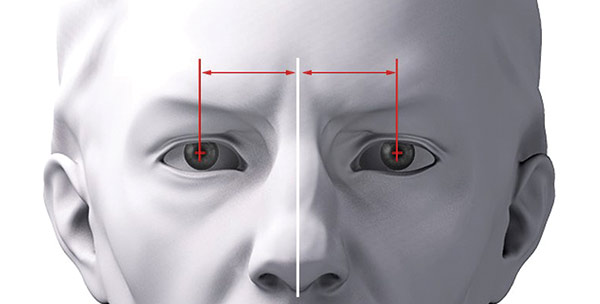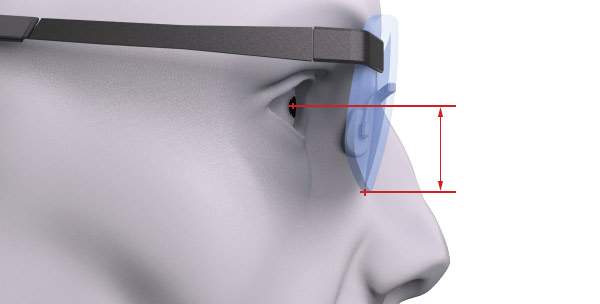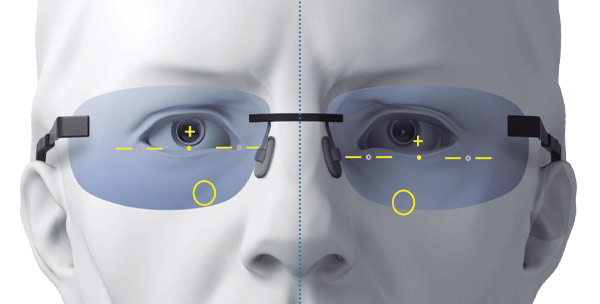Sponsored by IOT
By Deborah Kotob, ABOM
IOT is a leading resource for all things freeform, and in this spirit, this article is on progressive lens (PAL) fitting, dispensing and troubleshooting. In this article, we will review the correct frame to face fit when worn. We will also review some troubleshooting tips.
TAKING THE MEASUREMENTS
Always adjust the frame before taking measurements. The frame should fit the patient’s face the same when metrics are taken as the complete eyeglasses’ final fit.
The best lens performance requires precise fitting height, monocular PD and position-of-wear metrics for personalized freeform PAL designs. Digital and manual solutions for obtaining the position of wear measurements are widely available.
Note: Defaults are used for panto tilt, wrap angle and back vertex distance metrics when the lens is a non-personalized design or when the actual POW metrics are not provided to the lab.

FIG. 1 Interpupillary distance: Take a monocular PD with a pupilometer or digital metrics tool
VERIFY THE POWER AND FITTING PARAMETERS ACCURACY
Step 1: Verify the lens power with the PAL reference markings, then adjust the frame for final fit on the patient’s face. Note: If the markings are missing, remark the lens using the manufacturer-provided PAL design centration/cutout chart.
Step 2: Before removing the lens reference markings, have the patient try on the new pair of glasses. Explain to the patient that the lens has alignment markings that will be noticeable but necessary to confirm the reference points align with their eye. Let them know that you will remove the markings afterward.
Step 3: Use the centration chart or a PD ruler to verify the fitting height matches the height ordered. It is measured from the fitting cross to the inside and deepest groove of the frame. Also, check the near verification circle is complete and hasn’t been cut off during edging.
Step 4: Before checking alignment, adjust the frame to reflect the position-of-wear values provided to the lab, if dispensing a personalized freeform lens.

FIG. 2 Fitting height: Measure the fitting height from the pupil center to the deepest part of the frame eyewire
Step 5: With the frame on the patient’s face, check the fitting cross alignment. Slight adjustments can be made if needed. For example, if the lenses are sitting too high or low, increase the nosepad spread to lower the height or reduce the nosepad spread to raise the fitting cross height. Adding a small amount of pantoscopic tilt makes the reading zone more accessible to the patient and in effect, lowers the fitting height. Note: The frame for personalized progressive lenses should be returned to the POW parameters provided to the lab before dispensing the finished glasses. Since the lenses were compensated to optimize the lens for the way the frame fits the patient’s face, no changes in frame fit should be needed.

FIG. 3 The fitting cross of the left lens and the pupil center are misaligned. Additionally, part of the reading zone is cut off. The centration issue causes a problem for the left eye but will also affect binocular vision. Prism will be induced, and the eyes will not experience equal add power as they track down through the corridor into the intermediate and near zones. Cutting off part of the reading zone will reduce the clear near vision area in the lens. Fitting or edging centration/height errors require a redo.
TROUBLESHOOTING
Reapply reference markings and check the PD and fitting height alignment.
Distance - When the fitting reference marks align perfectly with the patient’s pupil centers and at the correct height but distance vision issues are experienced, the refraction may be incorrect. Recommendation: Repeat visual exam.
Near/Intermediate - If the patient demonstrates a distinct visual deficit at near vision or intermediate, double check their monocular PD, then make sure they can find near/intermediate zones in the lens by adjusting their chin up and dropping their eyes. Adjust the frame to raise or lower or add panto to increase access to near zones; retrain on PAL use.
- If the patient prefers to reach their reading zone faster, add a bit of pantoscopic tilt. Also, know that a short corridor lens will accomplish this.
- If the patient finds the intermediate area too narrow, tell them about specialty lenses designed for intermediate-range activities. Recommendation: Repeat visual exam if the above remedies fail.
If peripheral distortion from unwanted astigmatism causes general discomfort which does not resolve after one week, a softer lens design will help.













